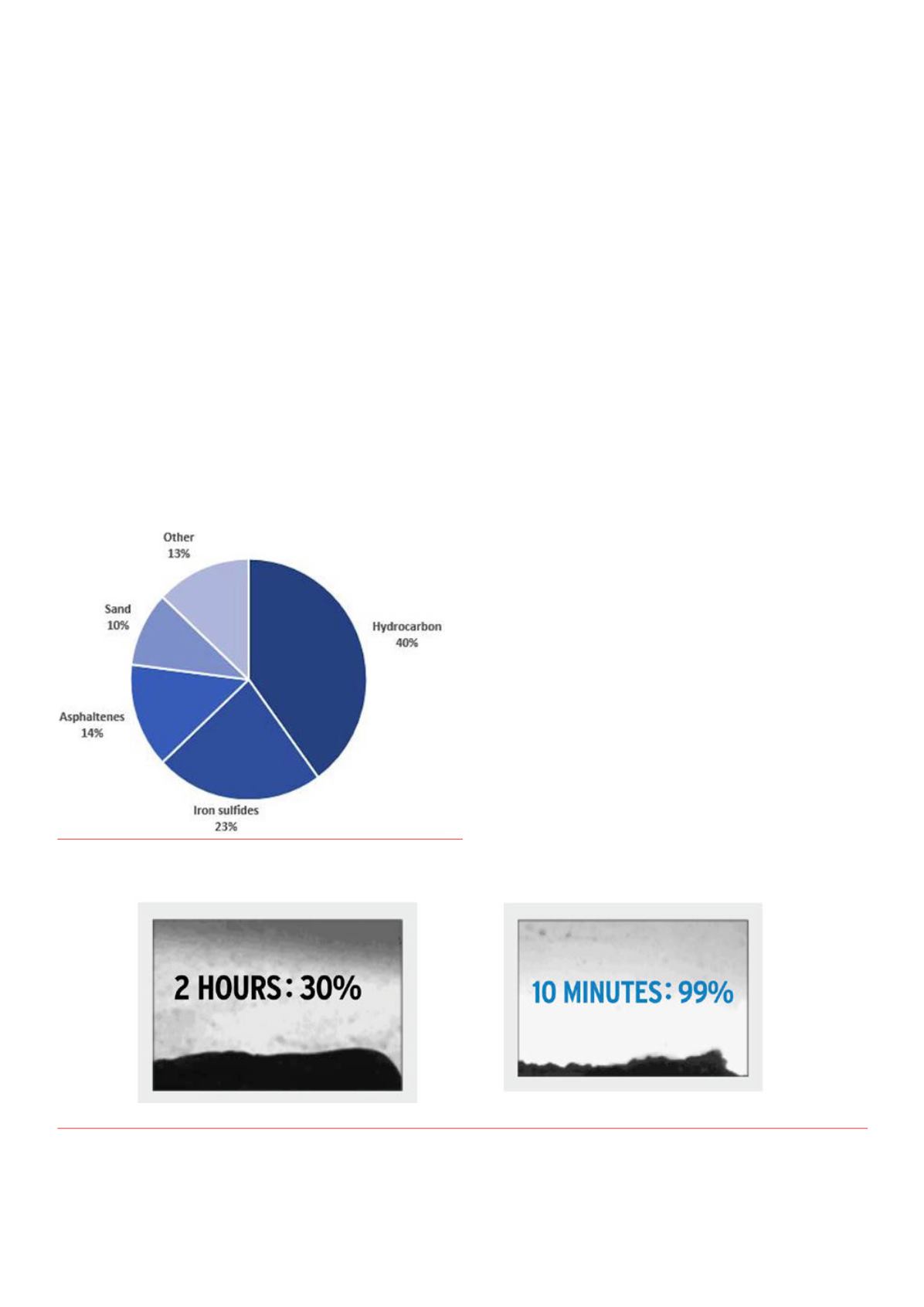
54 |
Oilfield Technology
June
2016
The main components are hydrocarbons, iron sulfides, asphaltenes,
sand, and clays (The relative ratio of each component will be system
specific). This combination results in an oily sludge that blocks
pore throats and coats the injection system. This oily sludge can
also provide an environment conducive to under-deposit corrosion
resulting in accelerated pipe failures.
Typical corrosion prevention involves injecting corrosion
inhibitors into production fluids and can be an extremely
cost-effective means of mitigating corrosion in carbon steel pipelines.
Unfortunately, the inhibitors are worthless if they cannot reach the
pipe wall. This is because this oily sludge forms a tenacious barrier
that cannot be penetrated by most corrosion inhibitors. It acts
as a parasitic surface adsorbing the inhibitor from the bulk liquid
phase. Consequently, these deposits can create significant integrity
management challenges.
Theneedforadifferent solution
The importance of keeping production equipment clean and the
difficulty in dealing with this oily sludge is clear. While the thickness
of oily sludge in a pipeline may range from only a few millimetres to
several centimetres or more, the outcome is the same: the sludge
may adsorb significant quantities of corrosion inhibitor, preventing
the inhibitor from reaching the pipe wall.
Thus the sludge deposits have to be physically removed from the
pipeline, typically through maintenance pigging operations. However,
in many fields with an older infrastructure, pig launchers and receivers
may not be installed, and even if they are, the pipe configuration
may have changed such that there is pipe of varying diameter along
the same line. It is often very difficult, if not impossible, to pig a line
like that. Pigging operations can also result in process upsets, lost
production, significant Opex costs, and EH&S challenges.
Recognising the importance of tackling this problemmore
than 10 years ago, Nalco Champion began a thorough research
effort, aimed at understanding the factors involved in successfully
removing oily sludge by chemical means, and then developing a
formulation that could effectively remove this sludge while also
mitigating aggressive corrosion. The company’s field operators in
North America dealing with the problem of corrosion under sludge
provided samples to staff scientists to assist with the research effort.
Compositional analysis revealed that the majority (40%) of the sludge
was hydrocarbon, which was essentially the ‘glue’ holding the solids
in the sludge together (Figure 1).
Researchefforts result inamulti-functional
technology
By focusing on a way to desorb or remove the hydrocarbon ‘glue’, the
remaining solids should be carried off the surface as well, allowing the
corrosion inhibitor to reach the pipe wall. Thus after extensive research
and testing, a multi-functional product was developed that was seen
to be significantly superior to conventional corrosion inhibitors at
removing oily deposits. The removed oil is emulsified as fine droplets
in the circulating brine phase. Since the oil is the ‘glue’ holding the
solid components of the deposit together, once it is removed, the
solids can also readily be removed and are held in suspension in the
brine. Reducing this obstruction enabled a significant increase in water
injectivity and consequently oil production.
In an initial laboratory test, at a dosage of 80 ppm, 99% of the
oily sludge was removed within 10 minutes (Figure 2). The corrosion
inhibition performance was further evaluated in a series of laboratory
tests. In virtually all studies performed, the new product was seen
to exhibit a performance superior to an established ‘best in class’
inhibitor. Even under shear stresses of 800 Pa, the product exhibited
95% protection at a dosage of 25 ppm. This performance was also
validated in field evaluations.
This product was named Clean n Cor®. When introduced into a
water injection system, the product is designed to clean away oily
Figure 1.
Compositional analysis of field sample of oily sludge.
Figure 2.
Photos of initial NalcoChampion newproduct lab test results. The image on the left shows that the best in-class inhibitor removed only 30%
of oily buildupafter two hours. The image on the right shows that after 10minutes, the Clean nCor technology removed 99%of the buildupdosage
at 80 ppm. Inboth lowand high shear tests. The new technology performedat least aswell as the best in-class product, providinggreater than 95%
protection efficiency at lowdosages between 5 and 25 ppm.


